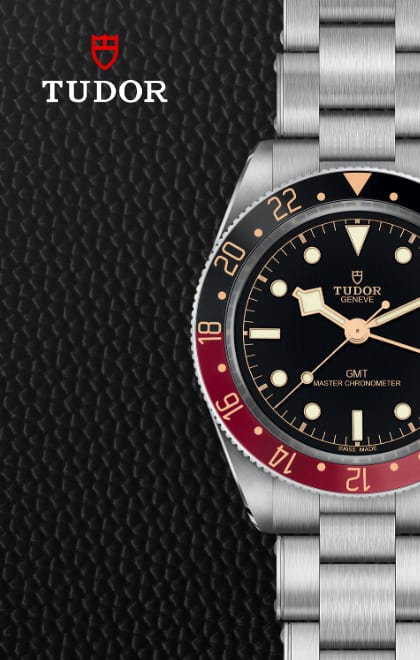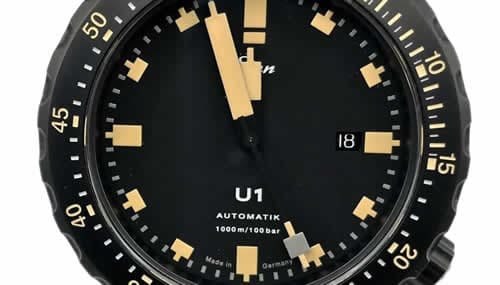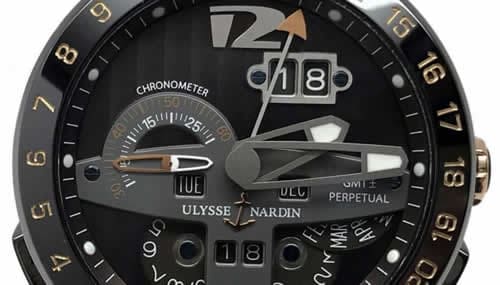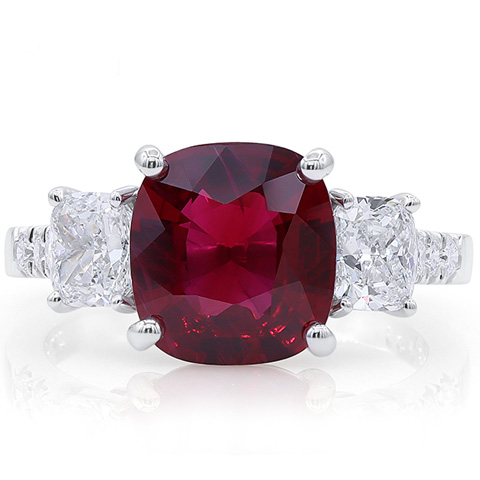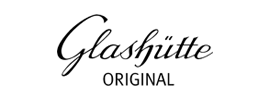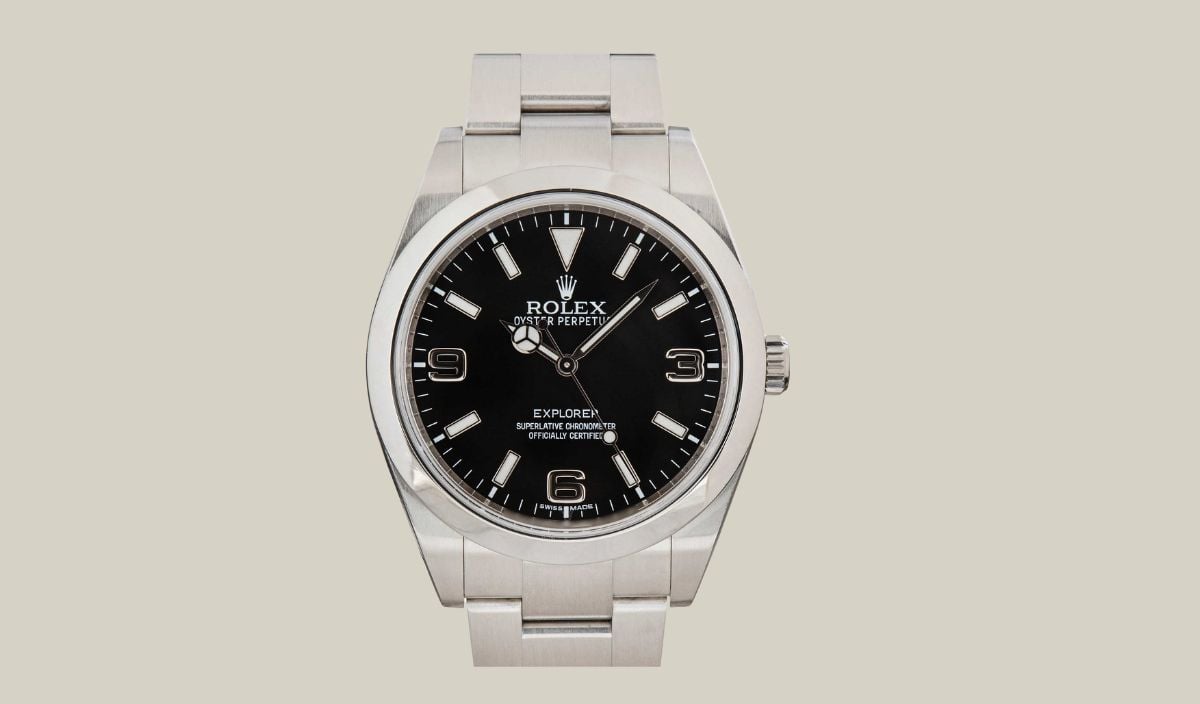
Rolex Explorer Review (Read BEFORE You Buy!)
Scrolling through the list of collections on Rolex’s website reveals just one icon after another. Datejust. Submariner. GMT-Master II.
The list reads more like a hall of fame for watches than a company website. You have to scroll past most of these other legends to reach the Explorer collection towards the end, almost as if Rolex is keeping this one hidden away for those with a little extra intentionality.
That extra searching will meet with a full reward, I assure you, for the Explorer collection is one of Rolex’s very finest. It couples Rolex’s traditional heritage with the tool watch style that they do best.
It’s simple and understated, which is central to Rolex’s historical identity. It is Rolex distilled to a single drop. No flash. No flair. Just a nearly perfect tool watch that works. And keeps on working.
Whether you’re scaling the highest mountains or clocking a 9 to 5, the Rolex Explorer captures the spirit of adventure in every moment. It can weather any storm, from a blizzard on Mount Everest to a rapidly approaching deadline. If you’re looking for a go-anywhere, do-anything watch by the watchmaking brand, look no further.
History
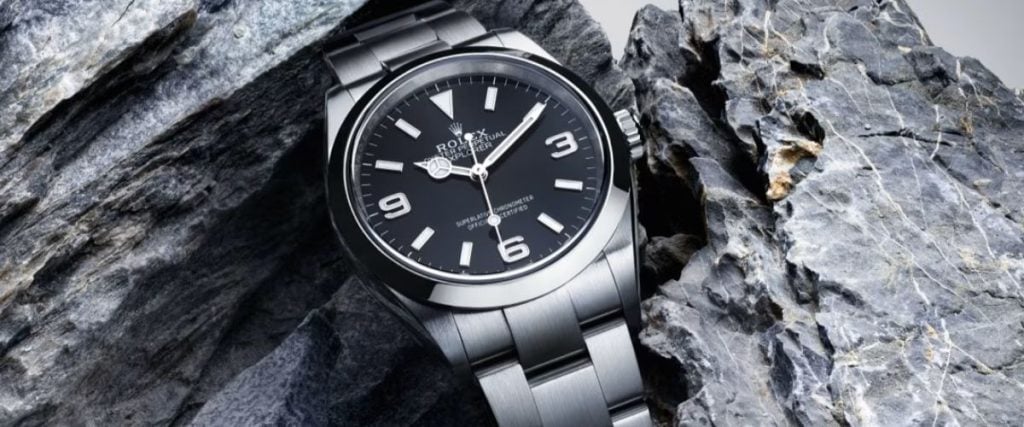
The Oyster Perpetual Explorer was first introduced by Rolex to commemorate the first-ever summit of Everest in 1953 by Sir Edmund Hillary. Contrary to popular belief, Hillary himself was wearing a Smiths watch, but his team was wearing Oyster Perpetuals.
As such, the Explorer itself wasn’t on the first summit of Everest, but mountaineering is in its DNA. From the inside out, it was designed to provide extreme precision even in extreme conditions.
The Explorer was one of Rolex’s first Professional watches. It’s far from the elegant flair of a Cartier Tank—essentially, it is for professionals, those pushing the limits of what is possible.
In the most extreme conditions, you don’t want a cheap battery-powered watch on your wrist that’s barely waterproof and could die at any moment.
Or at least, so the pros say. I wouldn’t know myself. The current editions of the Explorer were relatively recently updated, with the current 36mm size introduced in 2021 and the 40mm in 2023.
Thankfully for those of us who have a deep appreciation for vintage watches and heritage releases, not much has changed from the original edition of the Explorer—which actually first came out at the same 36mm size.
In all, it’s a watch that has remained faithful to its past. No need for vintage reissues here: the Explorer is the real deal and looks pretty much exactly how the original 1953 Explorer would look if it was introduced today.
Case
The Explorer case gets the job done, and it does it in probably the most understated possible way. It’s very simply brushed, creating a utilitarian tool-watch appearance uninterrupted by any polished bevels or flash.
This case can get beat up by pretty much anything anywhere and, thanks to the brushing, scratches, and divots, won’t be that visible or eye-catching. With brushed satin finishing, I often find that beat-up watches are able to wear their scars as a badge of honor in a way that highly polished watch cases really can’t, as any slight mark on their surface will interrupt their smooth shine.
The case is what Rolex calls their proprietary Oyster case. Originally introduced all the way back in 1926, it enabled Rolex to create the first-ever waterproof wristwatch.
At its core, it involves screwing the bezel and the caseback into place, using the tight seal created by the threads and by rubber gaskets to add water resistance. Today, the Explorer has 100m of water resistance thanks to this, which is more than enough to take it swimming, if not a little diving, without any worries.
As a watch nerd, I love the effect created by contrasting areas of polish on a case or bracelet. I’m a big sucker for that sort of visual contrast, and thankfully, the Explorer provides just that with its mirror-polished bezel atop the brushed case.
It’s a little extra flash and shine that pairs so well with the glossy black dial (more on that later) and really turns this watch into something that you can dress up when you want to.
That spectacular Oyster case construction that I touched on earlier is crafted entirely out of Rolex’s proprietary Oystersteel, a special type of steel in the 904L family.
According to Rolex (personally, I’ve never put one of their watches through its paces, but maybe one day), it’s significantly more corrosion-resistant and has a unique radiance when compared to standard stainless steel.
Again, Rolex is all about quality and simplicity. Corrosion resistance and a shinier, more precious-metal-like appearance? I’ll take both, please. The case is simple and fantastic. It gets the job done and protects the watch in a powerful and elegant way.
Dial
With the recent editions of the Explorer, Rolex has slightly altered the dial, with the primary changes being repositioning some text and switching the color from a matte black to a glossy black.
I’m a huge fan of this change—the text is now in the same configuration as the original Explorer, and the glossy black dial is just so much deeper and more elegant than a matte black could be. It’s the elegant shine of a black silk bow tie—simple and timeless.
Overall, the dial is designed to be as legible as possible. It features numerals at 3, 6, and 9, which are even larger than those in the last edition of the Explorer, as well as square lume plots at the others and a triangle at 12:00.
This layout is so iconic and so legible that it’s been copied on hundreds of watches throughout history. I think I’ll let that speak for itself.
Both the applied indices and the hands are filled with Rolex’s special Chromalight lume, which is a bright white during the day and, when charged by UV light, emits an intensely blue glow at night.
It’s a relatively recent development, from 2008, and it was updated in 2021 to make it an even more intense and longer-lasting shine.
Essentially, it’s a really high-quality lume that is definitely one of the key factors that will set the Explorer apart from similar but less expensive tool watches which will have vastly inferior lume.
The hands are quintessential Rolex, with the “mercedes” hour hand and simple pointed minute hand. I actually am quite fond of the seconds hand, with its round lume plot and round counterweight.
It’s just so visually and physically balanced and, to me, conveys a lovely sense of precision which is, of course, backed up by the powerful Rolex movement beating away inside.
Along the rehaut, you’ll find the iconic “ROLEX-ROLEX-ROLEX” repeated text engraved into the metal. A bit of a history lesson: all the way back in the 18th century, perhaps starting with Abraham-Louis Breguet, watchmakers were making fine and precision engravings in order to distinguish the quality of their work from that of counterfeiters.
It’s a lovely way to both add that hefty Rolex branding and, by adding such a delicate and difficult-to-reach engraving, provide a way to authenticate the watch at a glance.
Finally, the printed text is very evenly spaced and balanced, with clean kerning (the space between letters) that shows a lovely attention to detail characteristic of Rolex quality.
Every element of the whole dial shows a profound perfectionism, which is exactly what you pay for when you buy a Rolex or any other quality luxury watch. It’s legible and sporty but elegant, simple and restrained but refined. I really just can’t find any fault with it.
Movement
For a watch like the Explorer, you desperately need a movement that can take a few knocks in intense environments and keep right on ticking. Rolex has placed their in-house caliber 3230 in this role, which was developed in 2020.
It’s an automatic movement with a whopping 70-hour power reserve, so if you wear this watch every two days, it’ll always be wound. It’s COSC-certified as a chronometer, and to this, Rolex has added their own certification process, earning it the title of “Superlative Chronometer”, which means it keeps time to within +/- 2 seconds per day.
So how does it stand up to life’s adventures, wherever they may be? The cal. 3230 features all three of Rolex’s recent watchmaking developments: the blued Parachrom hairspring, the Rolex Chronergy escapement, and Paraflex shock absorbers.
Without getting too into the technical details of each of these, each one definitely brings some major benefits to the power and durability of this watch. The Parachrom hairspring increases the watch’s resistance to magnetic fields and also keeps great time even over a long span of time without regulation.
It’s also more resistant to breaking than standard hairsprings and silicon hairsprings, which have become the standard for the rest of the industry. The Chronergy escapement is what gives the cal. 3230 such a long power reserve, thanks to a significant increase in efficiency for the movement.
In all, it’s a movement designed to resist whatever life throws at you, especially since it’s safely ensconced within its strong Oyster case. There’s not much else I can say about it—it’s a workhorse time-only beater that will power you through all of life’s explorations.
Straps
The Explorer comes normally on a classic Rolex Oyster bracelet, as if the heritage inspiration couldn’t get any better. Once again, there’s not too much to say here and certainly nothing to nitpick at. The bracelet was first developed in the 1930s, so its design actually precedes the Explorer collection, interestingly enough.
Rolex has equipped this bracelet with both an Oysterlock folding clasp, which snaps over the buckle to hold it tightly shut and prevent it from coming open, and an Easylink rapid extension system, which can quickly add an extra 5mm to its length via a folding link.
This latter tool is much more useful than you’d think—your wrist actually fluctuates a little in size throughout the day depending on your level of physical activity and other factors, so the option to quickly pop 5mm onto the length can be actually super convenient.
I would strongly recommend keeping your Explorer permanently on its bracelet. The 36mm version has a 19mm lug width, which is quite difficult to find a good strap for—although the 40mm version is at 20mm, which is much easier.
That said, both of them are made with slots in the case wall between the lugs to better integrate the end link and make it look like it flows right into the case. This means that without the bracelet, you have those slots revealed, which can be a pretty ugly look from some angles.
Thankfully, the Oyster bracelet is great, and it’s really not too much of a loss. You can try to put a strap on it if you really want, but like I said, keeping it on the bracelet is probably the best option.
On-Wrist Experience
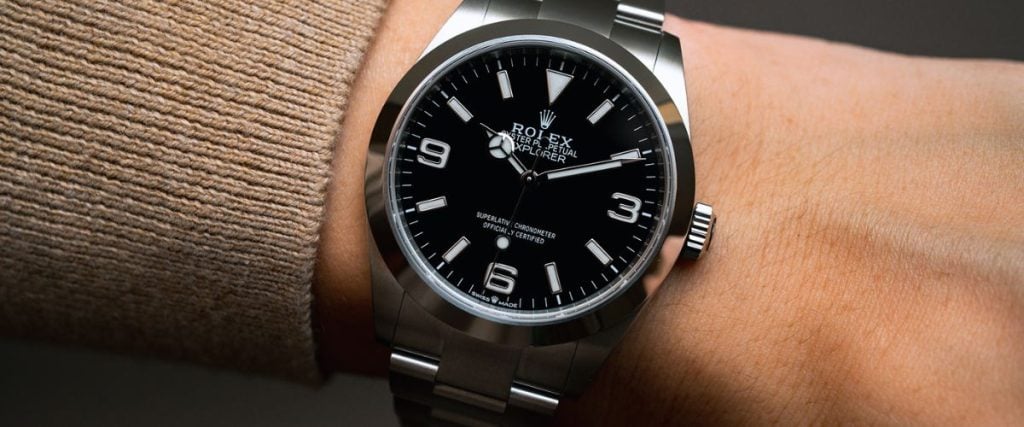
The Rolex Explorer wears amazingly and has a super unobtrusive presence on the wrist—just like you would expect, considering all the rest of the under-the-radar details we’ve discussed so far.
The 36mm version, in particular, is quite small by modern standards, and its 19mm lug width keeps its wrist presence rigidly restrained. It can definitely take some getting used to its small size, so you might need to give it a little more wrist time to adjust to it.
Explore the
Biggest Pre-Owned Collection of Luxury Watches
Once you do, however, I’ve found that it becomes natural and easy to wear, especially for those of us with smaller wrists. Honestly, 38mm is right around the sweet spot for me, so I don’t mind a 36mm version in the least, especially when it’s the vintage size.
The 40mm option is much larger and feels more modern in its sizing. It definitely doesn’t take over too much, but it’s enough to give it much more of a modern sports watch feel and look, sprawling over the wrist with its larger case size and lug width.
I’m really fascinated by just how much of a difference the case size can make in the overall appearance of the watch. The 36mm is quiet, elegant, and simple, with a pronounced vintage feel. The 40mm is bold but not over-the-top, sporty, and fresh.
Both are great watches in their own right and completely identical on every other level. But the difference in size is definitely something important to consider when purchasing your Explorer.
It’s a watch that, as I’ve mentioned before, can take anything you throw at it. I’m not exactly the type of guy who wanders around climbing mountains, but you can really just feel a sense of bravery and confidence when you wear the watch. Maybe it’s the Rolex name, maybe it’s the solid build and structure of the case, but it just feels strong.
In a way, it’s inspirational too. If I ever was going to climb a mountain, I’d wear an Explorer to do it. Maybe Rolex should test to see if some of the cal. 3230’s crazy high power reserve actually runs me, too, along with the hands when I’m wearing it…
Price & Availability
Currently, there are three different Explorer models available on Rolex’s website. There are two editions, all in Oystersteel, the 36mm and the 40mm versions. The 36mm goes for $7,350, and the 40mm is just slightly higher at $7,800. Finally, if you’re looking to really accentuate that elegant glossy black dial, you can spring for a two-tone yellow gold Rolesor model (only at 36mm) for $12,700.
I also want to touch quickly on the current market value of these watches since the gray market may be a better move if you don’t necessarily need it directly from Rolex, and they are, of course, expensive investments.
The 36mm and the 40mm Oystersteel versions are currently reselling for around their market value, with the 36mm slightly lower and the 40mm slightly higher. The big difference is in the Rolesor model, which has a lower market price of around $9,169.
Definitely not the watch to pick if you’re planning on reselling it, but that really shouldn’t matter. Pick the watch that you love, and that speaks to you!
Conclusion
Every time I take one of these deep dives into a Rolex collection, I walk away with a newfound appreciation for the simplicity and charm of Rolex’s work, and I hope I’ve conveyed that to you as well here.
The Explorer marries simplicity, refined elegance, and utilitarian strength in a way that many others have striven to emulate since its inception in 1953. It is, in many ways and for many people, the tool watch. Will it be yours?
About Exquisite Timepieces
Established in 1998, Exquisite Timepieces is your one-stop shop for all things luxury watches! We are an authorized dealer for 60+ luxury watch brands including Omega, Hublot, Seiko, & Longines! We are proud to showcase one of the world’s largest pre-owned watch collections, including renowned brands like Rolex and Patek Philippe. Check out our brand new watch arrivals here and popular pre-owned listings here.


